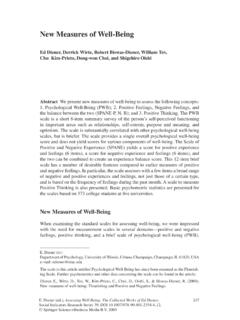Transcription of Cultural perspectives on attention deficit …
1 Journal of International Business and Cultural Studies Cultural perspectives on ADHD, Page 1 Cultural perspectives on attention deficit hyperactivity disorder: A comparison between Korea and the SeokYoung Moon The University of Arizona Abstract attention deficit Hyperactivity Disorder (ADHD) is one of the most commonly diagnosed behavioral disabilities in US classrooms. Even though the exact cause of ADHD is not known, several factors are known as possible causes, including heredity, genetic, and organizational factors, head injury, poor nutrition, infections, substance abuse, and exposure to toxins in early childhood.
2 Among many possible causes of ADHD, this author focused on Cultural perspectives on ADHD based on Ross s (1987) statement that each culture has different rates, behaviors, and perceptions of ADHD. By comparing Korean and US parents/teachers perspectives on ADHD through review of research, Cultural influence was determined to be one of the important factors affecting ADHD diagnosis and treatment. Keywords: ADHD, Confucianism, culture, East Asia, Korea, parents, teachers, USA Journal of International Business and Cultural Studies Cultural perspectives on ADHD, Page 2 INTRODUCTION attention deficit Hyperactivity Disorder (ADHD) is one of the most commonly diagnosed behavioral disabilities in the US classroom setting.
3 According to the consensus of National Institutes of Health (NIH), ADHD is estimated to affect three to five percent of school-age children in the US (1998). Researchers with the Centers for Disease Control and Prevention (CDC) analyzed data from the 2003 National Survey of Children s Health that revealed approximately million children aged 4 to17 years old were reported to have a history of ADHD diagnosis; of these, million (56%) were reported to be taking medication for the disorder (CDC, 2005, p. 842). Regardless of the high percentage of occurrence, however, children s ADHD is diagnosed only by teachers or parents observation in most cases. As Rowland, Lesesne, and Abramowits (2002) pointed out, a lack of reliable diagnoses, such as laboratory tests, has made reported estimates of prevalence difficult to interpret.
4 Every culture has children with ADHD (Barkley, Cook, & Jr. Diamond, 2002). Ross (1987) found that classrooms in Thailand have comparatively fewer students with ADHD because children are expected and trained to behave and talk quietly in public in Thailand. Likewise, East Asian countries have lower rates of ADHD diagnosis, mainly due to their Cultural background, Confucianism. East Asian societies highly value education, harmony with others, and loyalty to the country, parents, and elders. The Cultural environment of East Asian countries contributes to having fewer students with ADHD and different concerns in the classroom setting when compared to US classrooms. According to Lee (2008), students socioeconomic (SES) background also contributes to ADHD.
5 Based on the findings of the study, students from low income or single parent families, or families where both parents work, show a higher rate of ADHD than students from high income, two-parent families. Boyle, Offord, Racine, Szatmari, Fleming, and Sanford (1996) explained the reason could be family problems related to low economic status. Moore, DuPaul and White (2006) argued that the major contributive factors to ADHD are genetic and organizational factors: The brains of those with ADHD may differ with respect to the balance of certain chemicals, referred to as neurotransmitters, as well as the size and operation of specific brain components, such as the prefrontal cortex. Also, the nature of classroom tasks and behavior management styles at home and school could affect the expression of ADHD.
6 In this review of research, I answer the following question: Do Cultural influences impact ADHD diagnosis and treatment? I compare different Cultural views and treatments of ADHD among Korean teachers and parents and US teachers and parents. I also compare perspectives regarding ADHD in the two countries, focusing especially on medication, by looking at the history of ADHD. Causes of ADHD The exact cause of ADHD is not known. However, several factors are known as possible causes, including genetic factors: the brains of those with ADHD may differ with respect to the balance of certain chemicals, size, and operation of specific brain components. Ronald, Simonoff, Kuntsi, Asherson,Plomin, and McLoughlin (2008) examined genetic and environmental influences on ADHD in a large-scale twin study.
7 Substantial genetic influences were found for inattention and hyperactivity, as well as moderate to high genetic correlations between the two symptom domains. Even so, the genetic correlations between inattention and hyperactivity also Journal of International Business and Cultural Studies Cultural perspectives on ADHD, Page 3 show some etiological independence of the two symptom domains. Heredity is another factor. ADHD tends to run in families, which suggests that children may inherit a tendency to develop ADHD from their parents. Organizational factors, such as the nature of classroom tasks and behavior management styles at home and school, also are known to affect the expression of a child s ADHD.
8 Other possible factors are head injury, poor nutrition, infections, substance abuse, exposure to toxins such as lead in early childhood. ADHD Diagnosis and Treatment According to Singh (2008), reliable diagnosis rates for ADHD are difficult to find in most countries because medical or scientific diagnoses are not used to diagnose ADHD. Instead, teachers or parents observe symptoms of ADHD in a child and refer the child to doctors. Then doctors check whether symptoms have persisted for at least six months and whether symptoms and impairment have been present in at least two settings, such as at school and at home. Most of the time, if the child meets the criteria, doctors recommend that the child be medicated.
9 Breggin (2000) negatively described this process because under-resourced teachers may advise a parent of a misbehaving child to get immediate medication rather than utilize pedagogical techniques and resources. Generally, treatment with stimulant medication is known to improve the core symptoms of ADHD and has resulted in positive responses in more than 75 % of the children (APA, 2000). However, as many as 20 % of children showing ADHD symptoms derive no real benefit from medication. Rabiner, Anastopoulos, Costello, Hoyle, McCabe, and Swartzwelder (2009) stated that some children experience side effects, such as decreased appetite, weight loss, sleep problems, headaches, jitteriness, social withdrawal, and stomachaches that prevent the child from receiving medication.
10 Moreover, many children who benefit from medication still have difficulties with primary ADHD symptoms or associated problems that must be targeted via other means. Parents, teachers and doctors disengaging from the social responsibility to raise well-behaved children have been pointed out as another negative aspect of ADHD medication. Timimi (2002) argued that millions of children and their families are being treated unfairly by placing the children on highly addictive drugs with no evidence of long term benefits. Since stimulants are known as potentially addictive drugs with cardiovascular, nervous, digestive, endocrine and psychiatric side effects (Breggin, 2000), authors of a federal government report on ADHD concluded that no compelling evidence was available to support the claim that ADHD was a biochemical brain disorder (National Institutes of Health, 1998).














